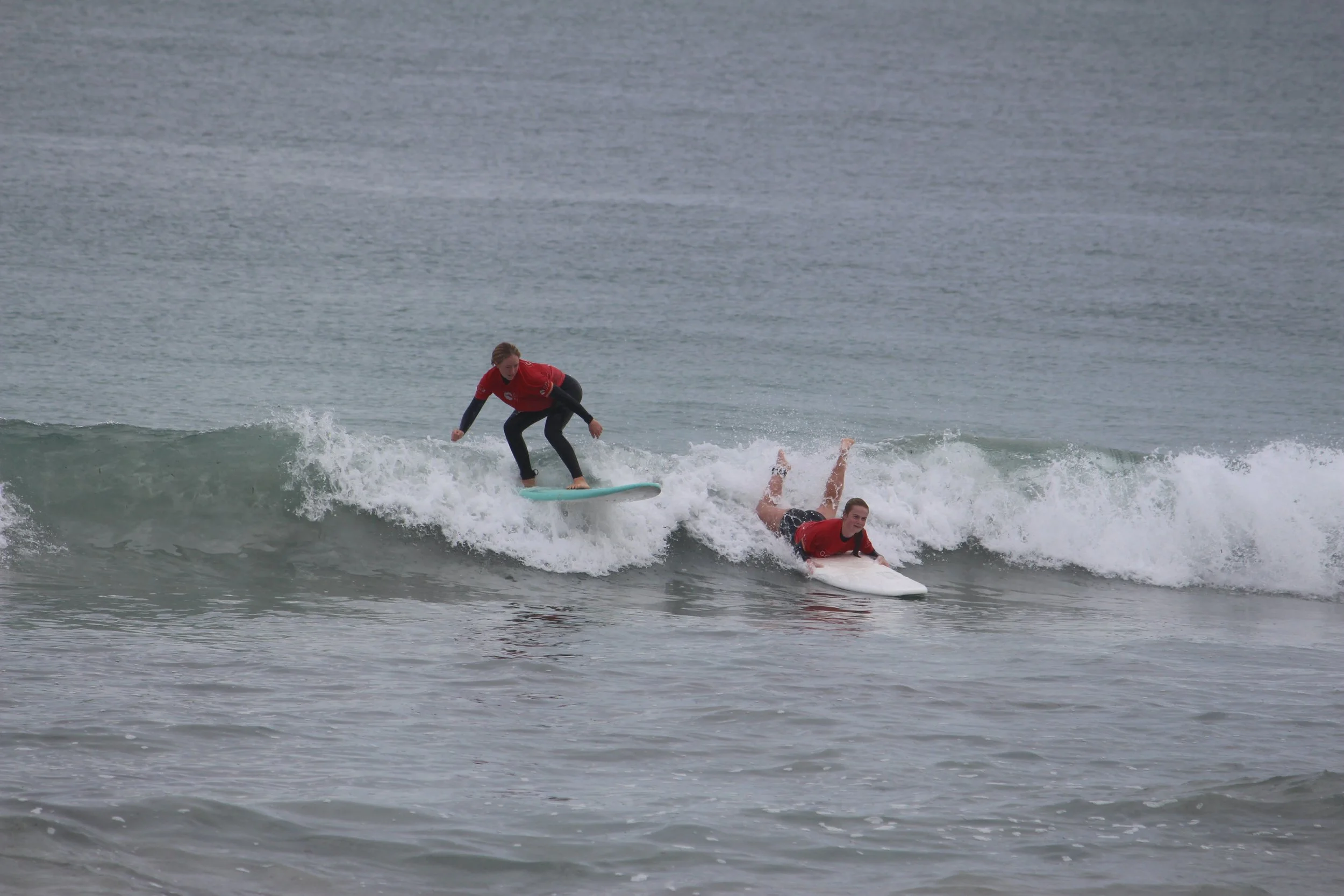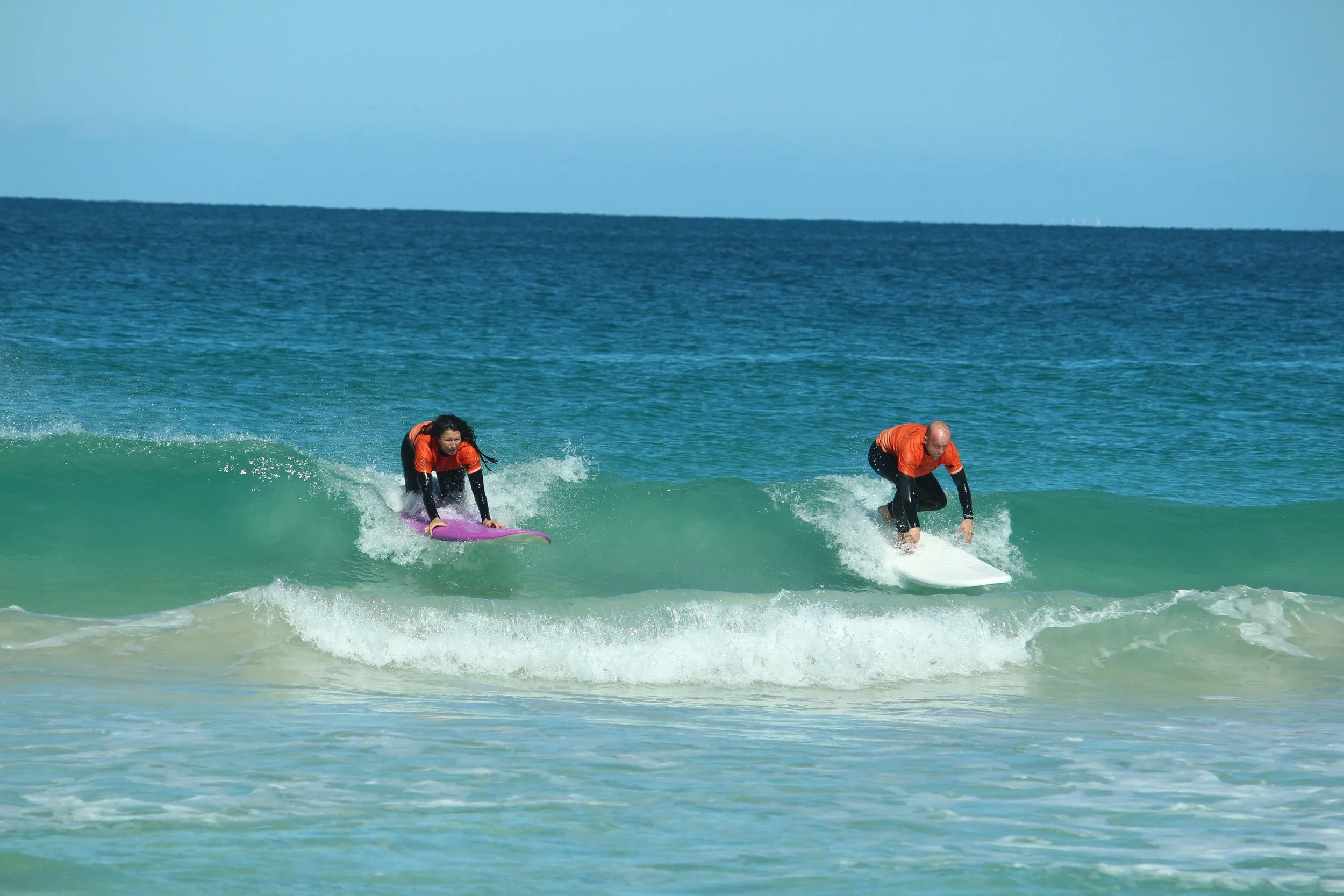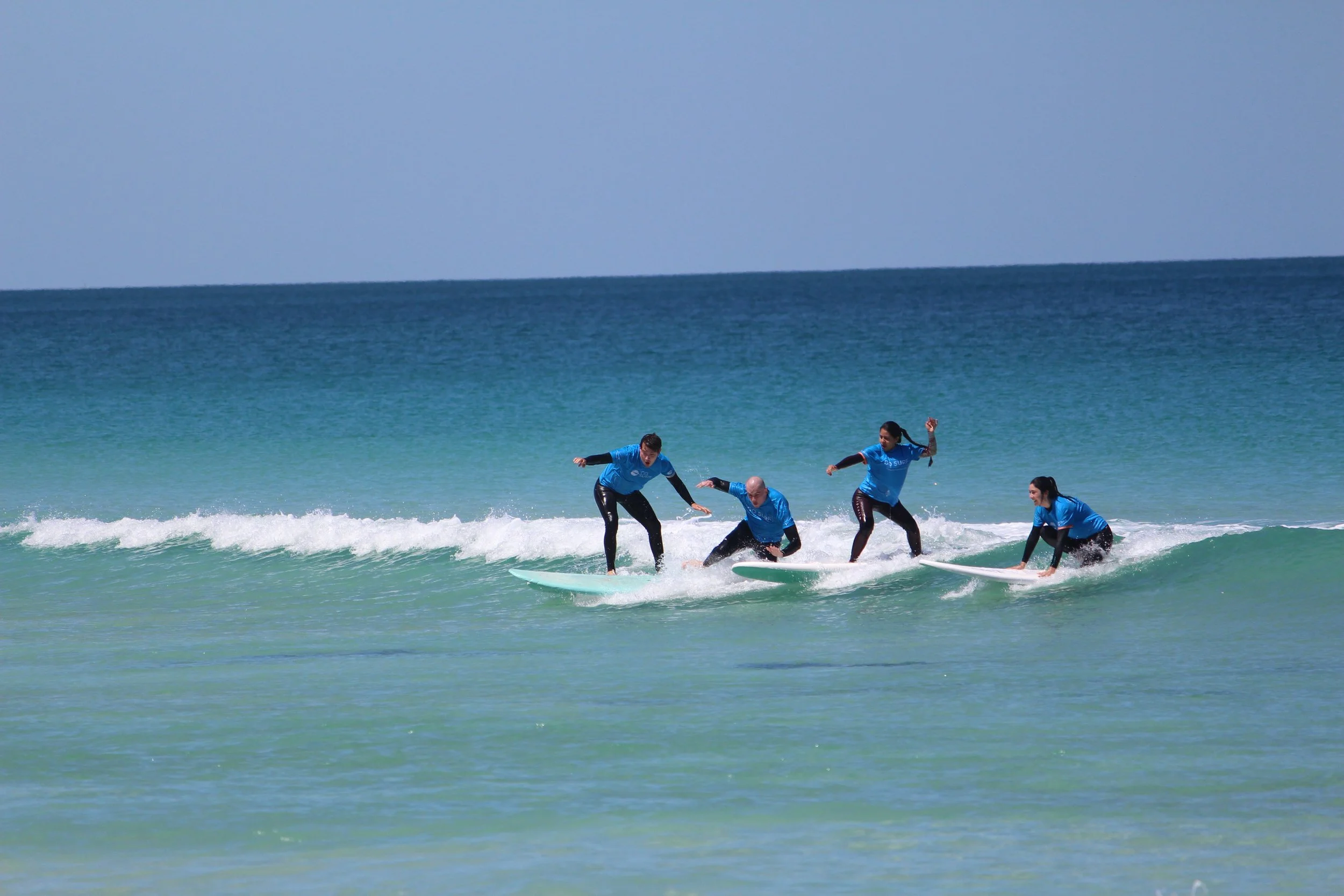Sitting in the lineup and catching waves might look like random acts from the shore, but there exists a complex set of rules known as surf etiquette that every surfer must follow.
These unwritten rules have been developed over centuries and are essential for maintaining order in the water. They prevent misunderstandings, keep us safe and ultimately ensure we all get our fill of waves!
At Go Surf, we teach you the fundamentals of surf etiquette during both group and private surf lessons in Perth.
To give you a deeper understanding though, it's worth exploring the history of surf etiquette and how it evolved into the system we know today.
Two surfers demonstrating proper surf etiquette in Perth, Western Australia. Learn about the history and unwritten rules of surfing at our Perth Surf School.
What is surf etiquette?
While most organised sports have rules in place that are clearly stated and enforced, surfing relies on an unwritten code of conduct that is universally understood among surfers.
You won't see these rules displayed on signs at any beginner beaches in Perth, nor can you find them in rule books, but they are passed on from one surfer to another through tradition and experience.
In fact, even calling them rules sounds too forced.
They're actually more like guidelines or common courtesies that ensure the safety and enjoyment of everyone in the water.
The history of surf etiquette, Hawaiian royalty and the Code of Kapu
While 'surf etiquette' is the term that's commonly used today, it wasn't always so.
The Code of Kapu was a code of conduct that controlled surfing in Hawaii.
It imposed strict rules and regulations on board sizes with specific times when only certain individuals could surf and reserved access to the best waves for royalty.
The Code of Kapu has since evolved into less of a strict set of rules and more of a way to show respect for fellow surfers in the water. But it's important to understand its origins to truly appreciate the unwritten rules of surfing.
The importance of surf etiquette in the water
Reduces conflicts: Following surf etiquette minimises misunderstandings and confrontations between surfers, promoting a harmonious environment
Enhances safety: Adhering to the guidelines helps to prevent accidents and injuries by outlining who has the right of way on a wave
Increases wave count: When surfers respect taking turns, it ensures a fairer distribution of waves, allowing everyone to get their share
Promotes respect: Demonstrating knowledge of surf etiquette gains respect from other surfers, essential for being welcomed into the lineup
Cultivates patience: Practising courtesy in the water teaches surfers to be patient, a virtue that is beneficial both in and out of the surfing world
Protects the environment: Surf etiquette includes respecting the beach and ocean, encouraging the preservation of surfing habitats
Builds community: Shared adherence to a code of conduct fosters a sense of community and belonging among surfers of all levels
Honours tradition: Respecting the unwritten rules pays homage to the sport's cultural heritage and its historical significance
Modern times and 7 unwritten rules of surfing
These days, the unwritten rules of surfing apply to everyone in the water, regardless of their level of experience, skill or even age!
They include respecting the lineup, taking turns, not dropping in on another person's wave and communicating your intentions.
The interpretation of surf etiquette rules can differ slightly from region to region, country to country. But the following 7 unwritten rules are found no matter where you go.
1. Know your limits
The most important rule of surf etiquette is to know your limits.
This means understanding your skill level and only paddling out in conditions that you can handle.
Paddling out to ride waves that are beyond your skill level not only puts you in danger but also endangers others in the water.
It's essential to be honest with yourself and respect your abilities.
If in doubt, observe whether there are other surfers of your skill level in the water. You can also ask a more experienced surfer whether the conditions are suitable for you to paddle out.
2. Understand right of way
Two surfers in Perth, Western Australia, riding a wave. The surfer with the white board should be giving way to the surfer with the purple board. Learn about the history and unwritten rules of surfing in our latest blog article.
Learners and beginners will be sharing whitewash waves when they first start out, which means that there will be more than one person paddling for, popping up and riding them to the shore.
Once you graduate to paddling out the back and riding green waves though, there's an understanding that it's one person to one wave.
This is a safety measure as much as a practical one, but it does bring us to the concept of right of way. Here's how it works:
There's only ever one surfer per wave
The surfer closest to the peak (where the wave is breaking) has priority
If you're paddling on the shoulder (further from the peak), you must yield to the surfer on the inside
3. Don't drop in or 'snake'
Not understanding or willfully ignoring right of way leads us to the topic of dropping in and snaking.
These are two actions that break the rules of right of way and one surfer per wave, leading to accidents and confrontations in the water.
Dropping in refers to when a surfer takes off on a wave in front of another surfer who has priority, essentially cutting them off and stealing their wave.
Think about it like a car pulling out in front of another car and almost causing an accident.
Snaking is when a surfer paddles around or across another person's path to catch a wave instead of waiting their turn.
Both these actions are considered highly disrespectful. Ultimately, they fall into the category of unforgivable surf sins.
4. Be aware of your surroundings
Being self-aware in the water can be tricky.
When you're trying so hard to paddle correctly on your surfboard, reach the lineup, catch waves and stay balanced, it's easy to forget about everything else.
But this is where accidents can happen.
It's vital to constantly scan the water around you and be mindful of other surfers in your vicinity.
Always look both ways before paddling for a wave and avoid surfing too close to others when you’re just starting out.
5. Never paddle out through the lineup
Speaking of paddling towards the lineup, did you know that it's considered bad form to paddle out through the lineup?
The lineup, for those who don't know, is a designated area where other surfers are waiting to catch waves.
Paddling through this area not only disrupts their ability to catch waves, but also increases your chances of getting hit by a wave or colliding with another surfer.
Always paddle out around the sides and avoid crossing in front of other surfers who are already on a wave.
This will ensure that everyone can enjoy their waves without interruptions.
6. Respect the beach
As a surfer, your love for surfing is intrinsically linked to Mother Nature.
Without waves, we're unable to enjoy this pastime that we love so much.
Showing respect and appreciation for the beach should come naturally once you understand that as a surfer, you have a responsibility to look after the natural environment.
This includes not littering, picking up any trash that you see on the beach or in the water and following any local environmental rules or regulations.
Additionally, be mindful of your impact on marine life and avoid damaging coral reefs or disturbing wildlife while out surfing.
7. Be friendly and supportive
At the end of the day, the people who you're surfing with are just like you: human beings enjoying nature and doing a sport that they love.
So why not show some friendly and supportive behaviour towards your fellow surfers?
A "How ya going?" or a small smile or nod can go a long way in creating a positive and welcoming atmosphere in the water.
And while you might not be skilled enough to offer advice, simple words of encouragement for another surfer can make their day.
Four surfers in Perth, Western Australia, riding a Party wave. Not demonstrating proper surf etiquette but among friends, in small waves of little consequence….the rules can be bent. Learn about the history and unwritten rules of surfing in our latest blog article.
Final thoughts
Surf etiquette and the unwritten rules of surfing can seem overwhelming, especially for beginners.
But remember, these rules are in place to ensure everyone's safety and enjoyment in the water. As you continue to surf and gain experience, following these rules will become second nature.
Essentially, be cool in the water, share the waves and try to have fun while respecting the ocean and your fellow surfers.
Get out there and put them into practice!


















